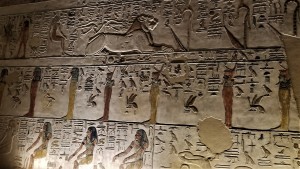Valley of the Kings – Sety I
Finally, here we are at the Valley of the Kings. On heck of a scorcher today, high is forecast to be around 106F. Thank God the Steigenberger Palace Hotel has a great pool. We’ll be there come 5pm. Off with the tomb tours.
With our Luxor Premium Pass, we can see all the tombs that are open, but we’ll settle for 6, the most well preserved and famous. One would think that going down into a tomb it would get cooler. Somehow that doesn’t work, at least not very well. Seems this limestone resonates heat so there isn’t much relief in the chamber.
First up, Sety I, second Pharaoh of the 19 Dynasty, 1292-1190BC. He ruled for 11 years (some say 15 but our guide said 11) and is the son of Ramesses I and father of Ramesses II. Sety gets its origin from Set, the Egyptian God of Chaos, War and Storms. Guess he wasn’t the best baby on the ole pyramid.

Hieroglyphics on the walls going down into the chamber. The Bee depicted life, death, reborn nobility
During his reign he re-established order; took back lands of Syria and Canaan (today that would be Israel, Palestine & Jordan); and enjoyed numerous military successes. He was married to Tuya, the daughter of a high ranking military officer, who provided Sety with a daughter named Tia, and as said earlier, a son named Ramesses II. Ramesses II was the chosen successor of the throne and is probably the best known Pharaoh of Egypt.
The tomb was first found in 1817 and was the deepest, most decorated tomb in the Valley. Several excavations have taken place over the years attempting to locate hidden treasure. Unfortunately, none has been found.
The mummy of Sety I was found to be in excellent condition. At the time of his death, he appeared to be around 40 years of age with no visible signs of disease or trauma. He was found decapitated but that was due to tomb robbers looking for gold and jewels buried on the mummy. His head was re-attached by a high priest and the mummy moved to the central urial site in Valley of the Kings. (A central burial site was used to try to hide the Pharaohs from tomb robbers.)













